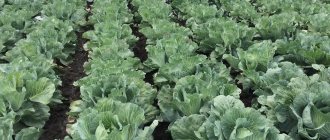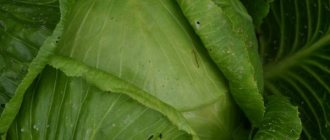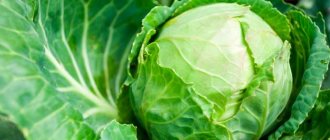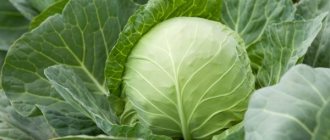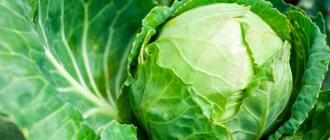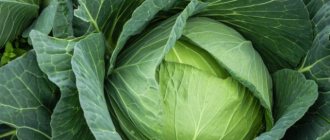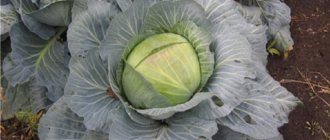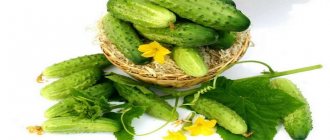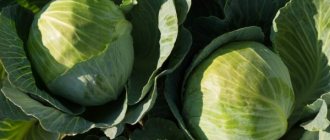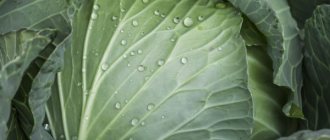Belorussian cabbage variety description, photo, characteristics, reviews, yield which are presented in this article, was bred by breeders from Belarus in 1937. Until now, it is very popular among Russian gardeners for its high yield and resistance to cold weather. On the contrary, Belorusskaya 85, Belorusskaya 455 and others appeared.
The Belorusskaya cabbage variety does not crack and is not afraid of cold weather. Belorusskaya 455 is susceptible to clubroot and vascular bacteriosis.
Description and characteristics of the variety
- Late ripening variety. The first forks of cabbage can be collected from the plot 110-120 days after the shoots appear. Belorusskaya 85 ripens after 140-150 days.
- For pouring forks, the ideal temperature is 20 degrees. At elevated temperatures and insufficient watering, yields deteriorate in the last stages of growth.
- Not susceptible to most cruciferous diseases. However, it will be necessary to combat vascular bacteriosis and clubroot.
- Susceptible to attack by pests.
- Weak root system located 25-30 cm from the soil surface.
- Tolerates low temperatures well. The variety is resistant to frost down to -4 degrees.
- The rosette can reach 70-90 cm in diameter. The leaves are slightly raised and semi-spreading.
- It gives a stable harvest; about 4.5-8 kg of cabbage is harvested from each square meter.
Reviews from ordinary gardeners
There are a lot of reviews online about Belorusskaya 455 cabbage. Gardeners say: the seeds of this variety do not require additional pre-planting treatment with special preparations. Nina (Moscow region) planted cabbage seedlings in May. It was favored by caterpillars, but the harvest turned out to be good. The heads of cabbage were stored well. And in any dish they fully revealed their taste properties.
Tatyana (Lipetsk) sowed varietal seeds directly into the ground on April 10. Germination was excellent. In the second half of September, the woman reaped a full harvest. The keeping quality and keeping quality of the heads of cabbage were excellent.
Belorusskaya cabbage 455 is a time-tested variety. Farmers plant it on an industrial scale. Cabbage is also suitable for growing on private plots.
Advantages and disadvantages
The advantages include the following characteristics:
- Stable high yield.
- Excellent taste and presentation.
- The heads of cabbage do not crack.
- Resistant to cold weather.
- Resistance to long-distance transport.
- Simultaneous maturation.
- Not susceptible to some cruciferous diseases.
White cabbage Belarusian has disadvantages:
- Susceptible to clubroot and bacteriosis.
- May be susceptible to attack by pests.
- Requirement for watering.
- During ripening, high temperatures reduce yield.
Despite these disadvantages, the variety is very popular among gardeners and consumers.
Characteristics of Belarusian cabbage
In addition to the description, when choosing a variety, you need to know the characteristic features of the crop. After all, cabbage is grown to produce tight forks. Therefore, you need to know at what time plants ripen, how they develop, and whether they suffer from diseases and pests.
Productivity and fruiting
Heads of cabbage ripen within 120-130 days from the moment of germination, that is, Belorusskaya 455 cabbage is a late-ripening variety. The ideal time for pouring forks is 20 degrees. High temperatures and insufficient watering negatively affect yields in the last stages of growth.
As for Belorusskaya 85 cabbage, the heads of cabbage are ready for cutting only after 140-150 days.
The weight of the fork variety with index 455 is from 4.5 to 8 kg per square meter. m. At Belorusskaya 85 it is a little lower.
Application area
A variety for universal use. Heads of cabbage are suitable for eating fresh salads, soups, and borscht. Stewed cabbage turns out delicious. But the most important thing for which this variety is grown is salting and fermentation.
Forks are well stored in the winter in the cellar until the end of January; you just need to remove the covering leaves.
Advice! If you intend to lay the heads of cabbage for winter consumption, then they must be removed before frost in dry weather.
Resistance to diseases and pests
The Belorusskaya variety is resistant to many crop diseases. But we will have to fight against clubroot and vascular bacteriosis. Insects also like juicy sweet heads of cabbage.
Advantages and disadvantages of the variety
Any plant has advantages and disadvantages, and Belarusian cabbage is no exception.
Advantages of the variety:
- high productivity;
- excellent taste, presence of a large amount of nutrients and vitamins;
- by the time of ripening, the heads of cabbage remain intact and do not crack;
- lowering the temperature does not cause harm;
- dense heads of cabbage tolerate transportation over long distances;
- maturation is friendly;
- good resistance to some diseases and pests.
If we consider the composition of the vegetable, then it contains:
- dry matter – 8.4-10.7%;
- sugar – 4.4-6.7%;
- ascorbic acid – 24-39 mg.
White cabbage Belorusskaya also has some disadvantages that should not be kept silent:
- It is difficult to protect plants from clubroot and bacteriosis;
- sweet heads of cabbage are loved by pests;
- it is necessary to water frequently and a lot;
- short shelf life;
- High temperatures at ripening reduce yield.
Despite its shortcomings, the variety is popular among gardeners and consumers.
Features of cultivation
Belarusian cabbage is not particularly demanding on growing conditions and produces a rich harvest with minimal care.
When and how to plant cabbage seedlings
In accordance with the timing, sowing of seeds is carried out 45-60 days before planting seedlings in the ground (late March - early April). However, it is necessary to focus on weather conditions in the region.
You can grow cabbage seedlings in separate pots, cassettes or common boxes. Fertile soil is prepared for seedlings, which can also be purchased at a garden store.
A day before sowing, the soil is disinfected with boiling water and potassium permanganate. This procedure will protect the plants from damage by the black leg, which can affect the seedlings.
Additionally, you can water the soil with Gamair or Alirin-B.
Seeds from packages do not need to be processed further. They are sown dry. However, for quick and smooth germination, it is recommended to treat the seed with a growth stimulator Zircon or Epin; you can also use potassium humate.
Sowing seeds for seedlings and care
- The soil is watered with warm water and the seeds are buried 1 cm. 4 cm are left between the rows.
- The plantings are covered with film. Seedlings grow best at a temperature of 18-20 degrees.
- When the sprouts emerge from the ground, the film is removed and they are kept for 7 days in a room with an air temperature of no more than 13 degrees during the day, and about 10 degrees at night.
- After 2-3 true leaves appear, picking is carried out. The soil is watered abundantly and the seedlings are transplanted along with a lump of earth. Next, the ground around the seedlings is sprinkled with calcined river sand.
- Watering should be moderate. Do not allow the soil to dry out or become waterlogged.
- Containers with sprouts are placed in a well-lit place. Under room conditions, it is necessary to organize additional illumination of the seedlings so that they do not stretch out.
- The seedlings need to be fed. You can apply mineral fertilizers. To do this, dilute 1 tbsp in 5 liters of water. spoon of urea. You can also use potassium sulfate or a solution of potassium permanganate, ammonia.
- Seedlings also need to be hardened off. 14 days before transplantation, they are taken outside, increasing the time from 15 minutes to the whole day.
Transplantation into open ground
Belorussian cabbage seedlings are planted in a permanent place in mid-June.
Cabbage needs light, organic-rich soil, a lot of light and moisture, most importantly, without waterlogging.
Choose a site that is well lit by the sun. The beds will need to be raised if groundwater is close to the groundwater level.
The beds are prepared in the fall. Add to each well:
- humus and phosphorus-potassium mineral fertilizers (3 g ammonium nitrate + 5 g potassium superphosphate + 4 g potassium salt.
Lime is added to soil with high acidity. It is also a good preventative measure against clubroot.
You need to take care of your plantings this way:
- Watering . Regular watering is required. The soil should be moist 40-50 cm deep. Watering is stopped 2 weeks before harvesting to avoid cracking of the forks.
- Loosening . After watering, the soil is loosened and weeds are removed.
- Feeding . Fertilizers are applied for the first time 2 weeks after planting in open ground. To do this, mullein (1:7) or chicken droppings (1:15) are diluted in water. Fertilizers are applied a second time after another 3 weeks. During the season, cabbage is fertilized 4-5 times.
- Hilling up . To increase the root system, cabbage needs to be hilled.
Harvesting and storage
Cabbage variety Belorusskaya 455 is harvested in August or September. The heads of cabbage are cut off with sharp knives, leaving a small stalk and part of the outer leaves. With a small number of plants, they are simply pulled out of the ground by the roots.
The harvested crop is inspected and sorted. Small, loose and damaged heads of cabbage are set aside for consumption and processing in the near future. Healthy heads weighing at least 2 kg, free from pests and diseases, as well as mechanical damage, are left for long-term storage.
Heads of cabbage prepared for the winter are kept for some time under a canopy or in a barn to allow the top leaves to dry and remove excess moisture from the product. To store cabbage, choose rooms with low humidity and good ventilation, maintaining a temperature of +3...+5 ºС. Cut heads of cabbage are kept in boxes, on shelves, or simply in a pile placed on wooden pallets. Cabbage, collected with a rosette of leaves and roots, is stored by hanging each head down.
We recommend reading
What varieties of cabbage are suitable for pickling, pickling and storing for the winter?
Schemes and rules for applying fertilizers to cabbage
Methods for storing cabbage in the cellar and at home
Rules for planting cabbage in open ground
Prevention of diseases and pests
Unlike hybrids, the Belorussky variety does not have immunity against clubroot and vascular bacteriosis. There is no effective means of combating these diseases, so if signs of infection are detected, the heads of cabbage must be uprooted and burned.
Disease prevention:
- compliance with crop rotation, plant cabbage every year in a new place;
- Do not throw cabbage leaves and roots into the compost heap;
- timely removal of weeds;
- fight against insects that spread the infection.
Planting seedlings in the ground
At the age of 35 - 50 days , seedlings must be planted in the ground. To do this, you should choose a cool day, and best of all, rainy days, during which the seedlings can easily survive the transplant and get sick.
Make holes with a distance of 50 by 50 cm . spill each hole with two liters of water, add humus and ash.
Place one root in each hole, place soil on top of the root, and press lightly. Do not add a lot of soil; the first leaves that remain on the stem should remain on top of the soil.
Add a little water again. If the weather is sunny, it is necessary to shade the seedlings for the first 3 to 4 days. After the cabbage leaves stand up, barriers and shelters must be removed.
Growth conditions
Seedlings should be in the sun for as long as possible.
For full development, seedlings should be in the sun for more time, the soil should not dry out . If possible, take it outside or into a greenhouse on warm days. Be sure to bring it into the house at night, since the optimal temperature for healthy growth is 18 degrees above zero, and in May the nights are quite cold.
Seedlings should be planted in the ground after one month of age, and ideally at the age of one and a half months . The stalk should be short and dense, thicker than a pencil.
Choose loamy soil and a place on the site that is illuminated by the sun in the morning. This is important for cabbage. She will survive the absence of daytime and evening sun just fine, but without morning sun she will get sick.
Despite the fact that this is a moisture-loving plant, do not make beds in the lowlands, and moreover, the beds need to be made higher - groundwater is destructive to the roots.
Care after landing
It is necessary to observe a daily watering regime.
After planting, it is necessary to water every day . In the evening, after the sun is closer to sunset, more than a liter of water must be poured under each root.
During the first week there is no need to loosen the root zone, but after a week, before watering, you need to loosen it.
Constant weeding will help to avoid excess dampness from weeds, and will allow you to immediately notice insect pests.
Two weeks after planting, stop daily watering. It is necessary to let the sprouts dry completely, and let them stand completely dry for a couple of days.
It is necessary to monitor the appearance of midges and caterpillars . When midges first appear, you need to spray the cabbage with soapy water and sprinkle wood ash on top.
Dilute laundry soap in a bucket of warm water until the water becomes white and soapy. Spray the leaves with this solution, especially the centers - the junction of the leaves with the cuttings, and the ground around.
When caterpillars appear, it is necessary to use special treatment products. The treatment should be carried out in calm weather, preferably in the evening, after the sun is closer to sunset.
Belorussian cabbage is susceptible to caterpillar damage
